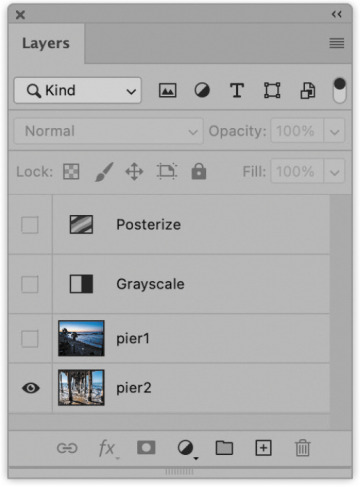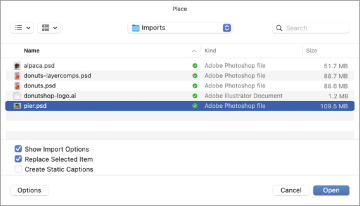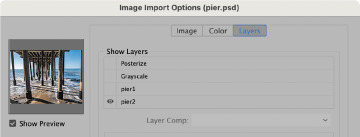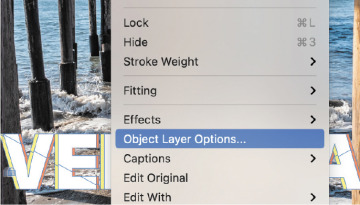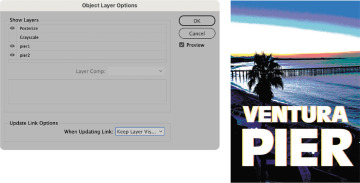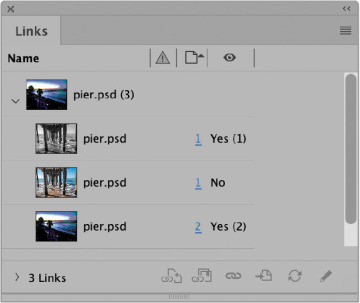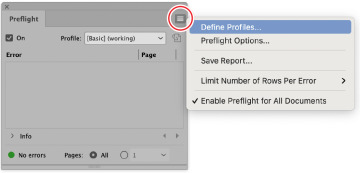Creating different versions using adjustment layers
In this first exercise you’ll learn how to radically change the look and feel of a Photoshop document in InDesign by showing or hiding adjustment layers. This technique allows us to create alternative versions of the same design using only a single Photoshop document.
Inspecting the Photoshop document
Start Photoshop, and choose Photoshop > Preferences > General (macOS) or Edit > Preferences > General (Windows).
The Preferences dialog box opens.
Click Reset Preferences On Quit and click OK in the confirmation dialog box. Then restart Photoshop.
Open pier.psd from the Lesson03/Imports folder.
Inspect the Layers panel and notice there are four layers in total:
An image layer named pier1
An image layer named pier2
An adjustment layer named Grayscale that converts all layers underneath it to black and white
An adjustment layer named Posterize that applies the Posterize effect to all layers underneath it
Placing the Photoshop document and overriding layers
Start InDesign, and then press Control+Option+Shift+Command/Alt+Shift+Ctrl to restore the default preferences.
When prompted, click Yes to delete the Adobe InDesign Settings file.
From the Lesson03 folder, open L03-postcard-start.indd.
Choose File > Save As, and save the file as L03-postcardWorking.indd.
Using the Selection tool
 , select the gray graphics frame on the page.
, select the gray graphics frame on the page.Choose File > Place, and navigate to the Imports subfolder within the Lesson03 folder. Select the file pier.psd and, if necessary, deselect Show Import Options at the bottom of the dialog box. Click Open to place the file.
Using the Selection tool
 , select the Ventura Pier text object. Note that the text has been converted to a graphics frame containing the text converted to outlines.
, select the Ventura Pier text object. Note that the text has been converted to a graphics frame containing the text converted to outlines.With the selection active, Choose File > Place.
Select pier.psd again, but this time, select Show Import Options before clicking Open.
Click Open to display the Image Import Options dialog box.
In the Image Import Options dialog box, click the Layers tab to display the document layers.
Click the empty area to the left of the Grayscale layer to make it visible. An eye icon appears and the preview window updates accordingly, showing a grayscale version of the image.
Click OK to place the alternate version of the photo in the text object. Keep the file open.
Overriding Photoshop layers after placing
Continue with the previous exercise and navigate to page two of L03-postcardWorking.indd.
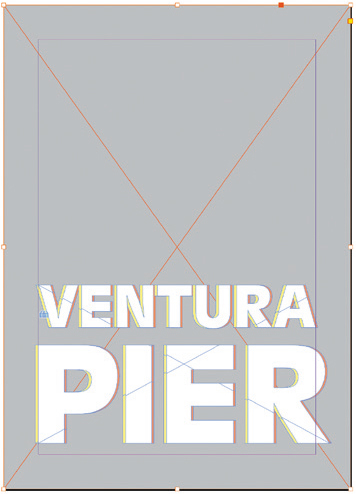
Select the gray graphics frame.
Choose File > Place.
Deselect Show Import Options.
Select pier.psd and click Open to place the file into the selected frame.
With the placed image selected, choose Object > Object Layer Options.
Click the empty column to the left of the pier1 layer to make it visible. Notice that the composition updates by showing an alternative image.
Click the empty column to the left of the Posterize layer to activate it.
The Posterize adjustment layer changes the appearance of the file.
Click OK to close the Object Layer Options dialog box, and keep the document open.
How to detect layer overrides in a document
To better prepare you for unpleasant surprises in InDesign when updating placed Photoshop documents, we need to have some sort of early warning system that tells us when layers of a placed file have been overridden. This isn’t a problem for the previous exercise because we clearly set the layer overrides ourselves. But we might be confronted with documents created by teammates, freelancers, or ourselves a long time ago. And in those cases, we might not know (or remember) the history or build-up of those documents. So how can InDesign assist us in these situations?
Viewing layer overrides in the Links panel
The Links panel in InDesign is a highly configurable panel and offers the ability to present you with link information that is hidden by default. Let’s set up the Links panel so it can show us which linked files have layer overrides in the document.
Choose Window > Links.
Open the panel menu and choose Panel Options.
At the top of the Panel Options dialog box, choose Large Rows from the Row Size menu to see larger thumbnails in the Links panel.
In the Show Column list, select Layer Overrides.
Click OK to close the dialog box.
If necessary, expand the Links panel to view the newly added Layer Overrides column.
The Layer Overrides column is represented by an eye icon. In this example we see the following information:
If you look closely, you can see that the thumbnails of pier.psd all look different, because each one represents a different version of the placed image.
Placed links that have overridden layers have a Yes in the column; ones whose visible layers match those of the linked document have a No in the column.
The number in parentheses next to the word Yes represents the number of layers that have been overridden.
Using the Preflight panel for detecting layer overrides
The Preflight panel allows you to set up automatic alerts based on set criteria when using text, setting document properties, managing colors, or working with images. It’s a sometimes overlooked feature within InDesign that can work to your advantage if you give it a little attention. In this scenario, we’ll configure the Preflight panel to alert us when layer overrides have been detected in the document. Unfortunately, the Preflight panel was built for detecting errors in a document that might prevent us from going to print—for example, image resolution that is too low, fonts that are too small, missing document bleed, and so on. This means that detected layer overrides will be listed as an error, whereas we only want a “heads up” when viewing documents, especially when opening documents we didn’t create ourselves. So take this “error message” in the Preflight panel with a grain of salt.
Choose Window > Output > Preflight.
Open the panel menu and choose Define Profiles.
Note the [Basic] profile in the left column, which is currently selected. This profile can’t be edited, so we need to make a copy of it first.
Click the plus icon at the bottom of the window to create a new profile, and name it layer overrides.
Click the arrowhead to the left of the IMAGES And OBJECTS category to display the available settings. Select Layer Visibility Overrides from the list.
You can set additional options, but doing so is beyond the scope of this book.
Click OK to close the dialog box.
Activate the newly created profile by choosing it from the Profile menu. Notice it has found two errors.
In the Error list, double-click the IMAGES And OBJECTS category and double-click Layer Visibility Override (2) to open the results of the search.
Double-click the first pier.psd item in the list of errors to navigate to the image in the document. Repeat this process for the second listing of pier.psd.
